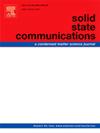Baric dependence of the rhodium melting point in the macro- and nanocrystal state
IF 2.4
4区 物理与天体物理
Q3 PHYSICS, CONDENSED MATTER
引用次数: 0
Abstract
The equation of state (P) as well as the baric dependences of the elastic modulus, thermal expansion coefficient, and melting temperature for rhodium (Rh) macrocrystal have been calculated by an analytical method using the paired Mie–Lennard-Jones interatomic interaction potential. The results showed good agreement with the data known from the literature. Using the same method, the change in the baric dependences of the melting temperature (Tm) and its pressure derivative (Tm′(P) = dTm/dP) during the transition from a macrocrystal to a nanocrystal of 306 Rh atoms was studied for the first time. It is shown that at all pressures the Tm(P, N) function decreases with an isomorphic-isobaric decrease in the number of atoms N. It is shown that the Tm′(P) value for a nanocrystal of 306 Rh atoms is larger at low pressures and smaller at P > 12.74 GPa than the Tm′(P) value for a macrocrystal.
宏观和纳米晶体状态下铑熔点的压强依赖性
用配对的Mie-Lennard-Jones原子相互作用势的解析方法计算了铑(Rh)大晶体的状态方程(P)以及弹性模量、热膨胀系数和熔化温度与压强的关系。结果与文献数据吻合良好。采用相同的方法,首次研究了从306个Rh原子的大晶向纳米晶转变过程中熔点温度(Tm)及其压力导数(Tm′(P) = dTm/dP)的压强依赖性变化。结果表明,在各种压力下,Tm(P, N)函数随原子数N的同构等压减小而减小。结果表明,306个Rh原子的纳米晶体的Tm ' (P)值在低压时较大,在P >时较小;比Tm′(P)值高12.74 GPa。
本文章由计算机程序翻译,如有差异,请以英文原文为准。
求助全文
约1分钟内获得全文
求助全文
来源期刊

Solid State Communications
物理-物理:凝聚态物理
CiteScore
3.40
自引率
4.80%
发文量
287
审稿时长
51 days
期刊介绍:
Solid State Communications is an international medium for the publication of short communications and original research articles on significant developments in condensed matter science, giving scientists immediate access to important, recently completed work. The journal publishes original experimental and theoretical research on the physical and chemical properties of solids and other condensed systems and also on their preparation. The submission of manuscripts reporting research on the basic physics of materials science and devices, as well as of state-of-the-art microstructures and nanostructures, is encouraged.
A coherent quantitative treatment emphasizing new physics is expected rather than a simple accumulation of experimental data. Consistent with these aims, the short communications should be kept concise and short, usually not longer than six printed pages. The number of figures and tables should also be kept to a minimum. Solid State Communications now also welcomes original research articles without length restrictions.
The Fast-Track section of Solid State Communications is the venue for very rapid publication of short communications on significant developments in condensed matter science. The goal is to offer the broad condensed matter community quick and immediate access to publish recently completed papers in research areas that are rapidly evolving and in which there are developments with great potential impact.
 求助内容:
求助内容: 应助结果提醒方式:
应助结果提醒方式:


